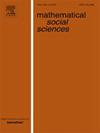单纯形减法估计顺序多数表决中一致意见的违反
IF 0.7
4区 经济学
Q4 ECONOMICS
引用次数: 0
摘要
基于Saari的投票几何(见Saari(1995)),我们引入了一种简洁的几何“单纯形减法”方法来衡量在公正匿名文化假设下顺序多数投票推翻一致同意的可能性。这种方法可以作为Nehring等人(2016)的替代方案,他们为离散选民建立了最坏情况界限。在一个候选人被一致拒绝后,我们将投票份额视为简化单纯形中的点。通过系统地去除较小的角子简单体的体积,我们恢复了Nehring等人(2016)确定的概率,该概率在七个候选对象中达到最大值。然后,我们将我们的方法推广到任意的绝对多数规则,并确定一致违反成为不可能的确切阈值。本文章由计算机程序翻译,如有差异,请以英文原文为准。
Simplex subtraction to estimate unanimity violations in sequential majority voting
Based on Saari’s geometry of voting (see Saari (1995)), we introduce a concise geometric “simplex subtraction” approach to measure the likelihood with which sequential majority voting overturns unanimous consent under the impartial anonymous culture assumption. This approach can be used as an alternative to Nehring et al. (2016) who establish worst-case bounds for discrete electorates. We treat vote shares as points in the reduced simplex after one candidate is unanimously rejected. By systematically removing the volumes of smaller corner sub-simplexes, we recover the probabilities determined by Nehring et al. (2016), which reaches its maximum for seven candidates. We then generalize our method to arbitrary supermajority rules and identify the exact threshold at which unanimity violations become impossible.
求助全文
通过发布文献求助,成功后即可免费获取论文全文。
去求助
来源期刊

Mathematical Social Sciences
数学-数学跨学科应用
CiteScore
1.30
自引率
0.00%
发文量
55
审稿时长
59 days
期刊介绍:
The international, interdisciplinary journal Mathematical Social Sciences publishes original research articles, survey papers, short notes and book reviews. The journal emphasizes the unity of mathematical modelling in economics, psychology, political sciences, sociology and other social sciences.
Topics of particular interest include the fundamental aspects of choice, information, and preferences (decision science) and of interaction (game theory and economic theory), the measurement of utility, welfare and inequality, the formal theories of justice and implementation, voting rules, cooperative games, fair division, cost allocation, bargaining, matching, social networks, and evolutionary and other dynamics models.
Papers published by the journal are mathematically rigorous but no bounds, from above or from below, limits their technical level. All mathematical techniques may be used. The articles should be self-contained and readable by social scientists trained in mathematics.
 求助内容:
求助内容: 应助结果提醒方式:
应助结果提醒方式:


